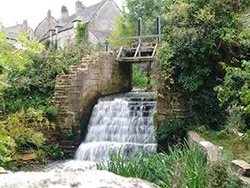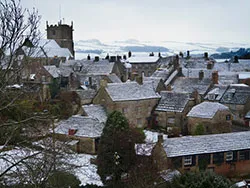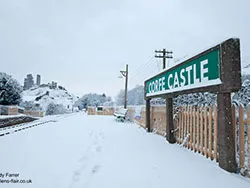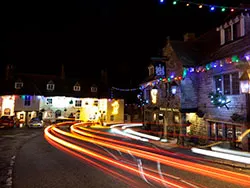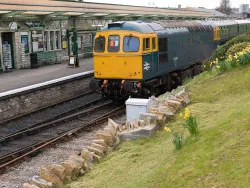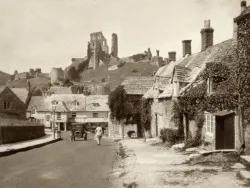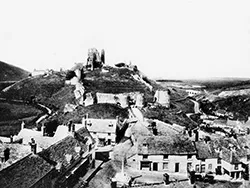
Corfe Castle in the Isle of Purbeck
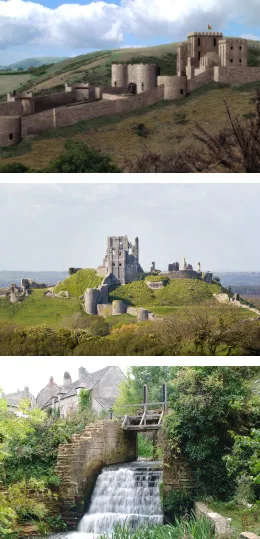
Corfe Castle is a picturesque village in Dorset, England. Known for its dramatic ruins of Corfe Castle, the village offers a glimpse into history and a chance to explore beautiful landscapes. Corfe Castle is accessible by car, bus, and the Swanage Railway. It’s a short drive from the coastal town of Swanage and nearby Wareham.
Village Life and Quaint Charm
The village of Corfe Castle beckons with its idyllic charm and traditional character. The streets are lined with picturesque cottages adorned with colourful flowers, inviting visitors to wander and explore. Artisan shops, tearooms, model village, and local pubs offer delightful opportunities to immerse yourself in the warmth of village life. Indulge in a cream tea, sample local delicacies, or browse local artisans' unique crafts and souvenirs.
Natural Beauty and Outdoor Adventures
Corfe Castle's setting amidst the natural splendour of Dorset is truly awe-inspiring. Surrounded by rolling hills, verdant valleys, and enchanting woodlands, the village is a paradise for nature enthusiasts and outdoor adventurers. The Purbeck Hills provide ample opportunities for hiking, cycling, and scenic walks, allowing visitors to immerse themselves in the region's tranquillity and soak in the panoramic vistas. The stunning Jurassic Coast and its iconic landmarks, such as Durdle Door and Lulworth Cove, are within easy reach for those seeking coastal beauty.
Community Events and Festivities
Corfe Castle's vibrant community spirit comes alive through a variety of events and festivities held throughout the year. From traditional fairs and village shows to historical reenactments, these events offer visitors a chance to experience the local culture and forge connections with the friendly residents. The village's annual carnival, complete with colourful processions and lively entertainment, is a highlight not to be missed.
The author Enid Blyton featured many locations in the Isle of Purbeck and Corfe Castle in her books, including the Famous Five and Noddy.
The Castle, a Historic Icon
At the heart of the village stands the magnificent Corfe Castle built by William the Conqueror, an architectural marvel that dates back to the 11th century. Built by the Normans as one of their great strongholds, it replaced an earlier Saxon royal house and symbolised power and authority. The castle witnessed various historical events, including its use as a state prison by King John and later as a treasury and hunting lodge. Its strategic location atop a hill, surrounded by the Purbeck Hills and cut by the Corfe River, only adds to its allure.
Corfe Castle has fulfilled various roles throughout its existence, each contributing to its illustrious history. In 1201, it was utilised by King John as a state prison, emphasising its strategic significance. Edward the Martyr was murdered in March 978. Later in 1205, the castle transformed into John's treasury and hunting lodge, showcasing its multifaceted nature as a royal residence.
During the 14th century, Sir John Maltravers, a prominent landowner in the Isle of Purbeck, used the castle to hold King Edward prisoner, further solidifying its importance as a seat of power and control in the region. However, in the 16th century, the castle found its last owners in the Bankes family, who would witness its ultimate destruction.
Renowned for its imposing structure, steep slopes and thick walls, Corfe Castle stood as an almost impenetrable fortress, successfully withstanding numerous assaults for over five centuries. However, during the English Civil War in 1643, the castle faced a relentless attack from Parliamentary soldiers.
Throughout most of the civil war, Lady Mary Bankes, a determined defender of the castle, held her ground against the Parliamentary forces. Despite her valiant efforts, one of Lady Bankes' men, Lieutenant-Colonel Thomas Pitman, betrayed her trust and allowed a group of enemy soldiers to enter through the main gate, leading to the castle's eventual fall from within.
The House of Commons, incensed by the resistance of the Bankes family and the castle's strategic significance, ordered its destruction. Over several months, relentless tunnelling and using explosives reduced the formidable fortress to the haunting ruins that stand today—a testament to the ravages of war.
Interestingly, the stonework from the demolished castle found a new purpose in the construction of Corfe village, further intertwining the history of the castle and its surroundings. However, in more recent times, the ruins came under the care of the National Trust, ensuring their preservation and making them accessible to the public throughout the year.
Exploring the Ruins
Walking amidst the atmospheric ruins of Corfe Castle is like stepping back in time. The towering remnants of the castle walls, gatehouse, and towers paint a vivid picture of its former grandeur. As you wander through the castle grounds, you can imagine the bustling life that once thrived within its sturdy walls. Take a moment to climb to the vantage points, where panoramic views of the surrounding countryside await, providing a breathtaking backdrop for photographs and a glimpse into the castle's strategic significance.
Preservation and Accessibility
The ruins of Corfe Castle are now under the care of the National Trust, ensuring their preservation for future generations.
The National Trust provides guided tours, interactive exhibitions, and educational programs that delve deeper into the castle's history, offering visitors a comprehensive understanding of its significance. The site is open to the public throughout the year, allowing everyone to explore and appreciate this remarkable piece of England's heritage.
Corfe Castle in 1643
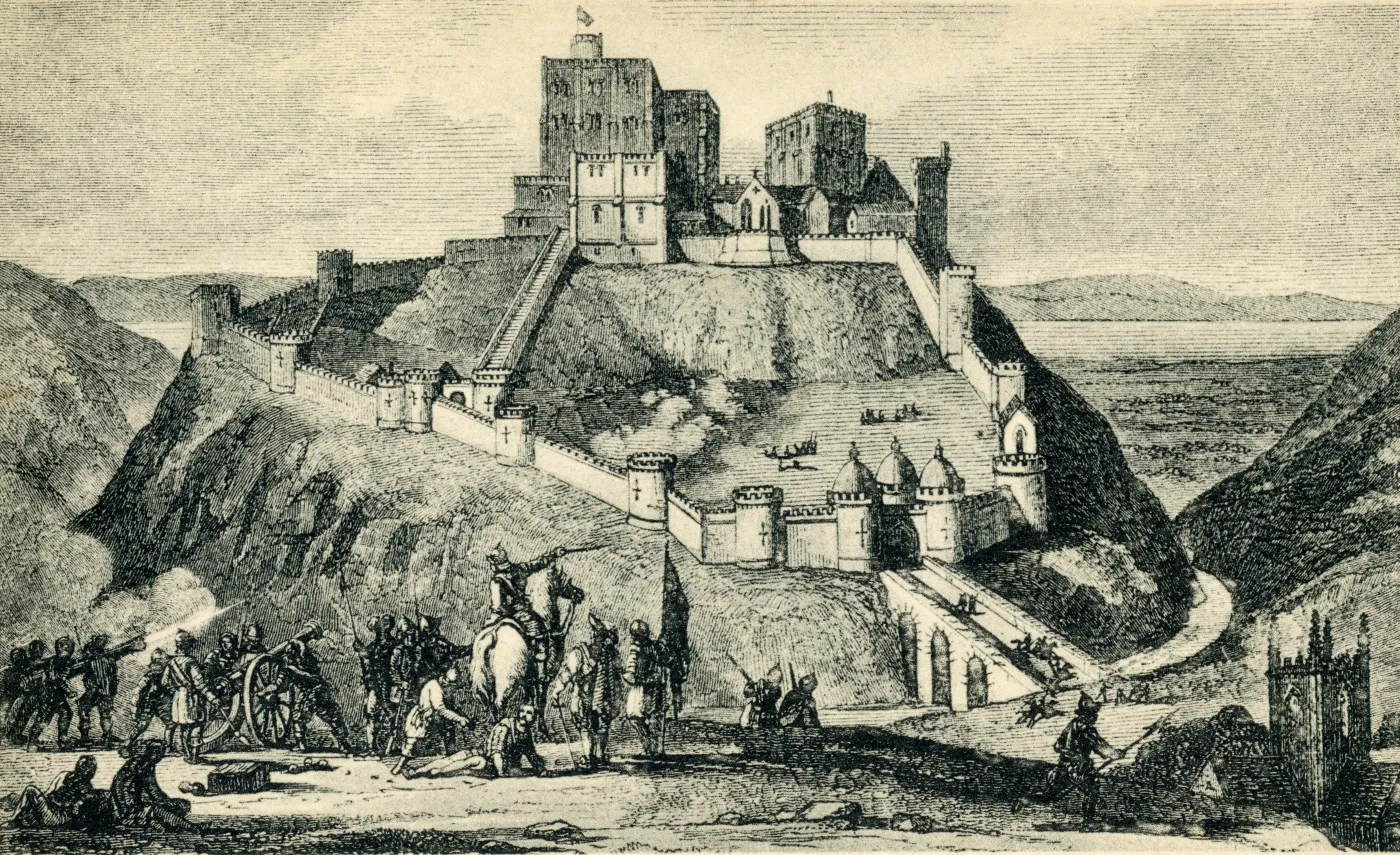
Getting There
Corfe Castle is reached by the B3531 from Wareham, or it is accessible from Swanage or from Poole via Wareham. There are three car parks, some free, with spaces for the disabled.
The nearest train stations are Poole and Bournemouth. The Swanage Railway runs from Corfe Castle to Swanage and you can take a steam train from Swanage to Corfe Castle. Buses go to Studland from Poole, Bournemouth and Swanage.
More information about Corfe Castle can be found on the Corfe Castle village website.
Location
Nearby...
Dorset Adventure Park
Attraction -
0.34 miles away
Purbeck Mineral and Mining Museum
Attraction -
0.38 miles away
Church Knowle
Attraction -
1.21 miles away
Blue Pool
Attraction -
1.62 miles away
Kingston
Attraction -
1.68 miles away
Creech
Attraction -
1.77 miles away
Burngate Purbeck Stone Centre
Attraction -
2.84 miles away
Kimmeridge
Attraction -
3.08 miles away
Spyway Dinosaur Footprints
Attraction -
3.16 miles away
Worth Matravers
Attraction -
3.19 miles away
